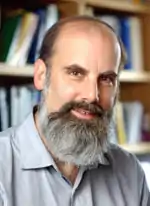Matthew P. Scott
Matthew P. Scott is an American biologist who was the tenth president of the Carnegie Institution for Science.[3] While at Stanford University, Scott studied how embryonic and later development is governed by proteins that control gene activity and cell signaling processes.[4] [5] He co-[6] discovered homeobox genes in Drosophila melanogaster working with Amy J. Weiner at Indiana University.[7][8]
Matt Scott | |
|---|---|
 | |
| Born | Matthew P. Scott |
| Citizenship | United States |
| Alma mater | Massachusetts Institute of Technology |
| Known for | Homeobox |
| Spouse | Margaret T. Fuller |
| Awards | Member of the National Academy of Sciences (1999)[1] |
| Scientific career | |
| Fields | Developmental biology |
| Institutions | Stanford University Carnegie Institution for Science University of Colorado Boulder Indiana University |
| Doctoral advisor | Mary Lou Pardue |
| Notable students | Sean B. Carroll Chris Q. Doe Eileen Furlong (postdoc)[2] |
| Website | profiles |
Among his laboratory's discoveries, he is recognized for the cloning of the patched gene family and demonstration that a human homolog PTCH1 is a key tumor suppressor gene for the Hedgehog signaling pathway as well as the causative gene for the nevoid basal cell carcinoma syndrome, or Gorlin syndrome.[9][10]
Education
Scott completed a B.S. in 1975 and Ph.D. in Biology in 1980, both at Massachusetts Institute of Technology.[11]
Career and research
Scott served on the faculty of the Department of Molecular, Cellular, and Developmental Biology at the University of Colorado starting in 1983. He moved to Stanford University in 1990 to join the faculty of the Department of Developmental Biology and the Department of Genetics. From 2002-2007 he served as Chair of Bio-X, Stanford's interdisciplinary biosciences program.[12]
Awards and honors
- 1983 - Helen Hay Whitney postdoctoral fellowship
- 1985 - Searle Scholar[13]
- 2004 - Conklin Medal, Society for Developmental Biology
- 1999 - Member, United States National Academy of Sciences[1]
- 2007 - Member, National Institute of Medicine
Personal life
He is married to Stanford developmental geneticist Margaret T. Fuller.
References
- "Matthew P. Scott".
- Furlong, Eileen E.M.; Profitt, David; Scott, Matthew P. (2001). "Automated sorting of live transgenic embryos". Nature Biotechnology. 19 (2): 153–156. doi:10.1038/84422. ISSN 1087-0156. PMID 11175730. S2CID 14228050.
- "Matthew P. Scott's Profile | Stanford Profiles".
- "Scott lab homepage at Stanford University". Archived from the original on 2008-12-04. Retrieved 2009-04-10.
- "HHMI Scientist Bio: Matthew P. Scott, Ph.D." Retrieved 2009-04-10.
- Amy J Weiner PhD Thesis Indiana University 1983
- Scott, M. P. (1984). "Structural Relationships among Genes That Control Development: Sequence Homology between the Antennapedia, Ultrabithorax, and Fushi Tarazu Loci of Drosophila". Proceedings of the National Academy of Sciences. 81 (13): 4115–4119. Bibcode:1984PNAS...81.4115S. doi:10.1073/pnas.81.13.4115. PMC 345379. PMID 6330741.
- Laughon, A.; Scott, M. P. (1984). "Sequence of a Drosophila segmentation gene: Protein structure homology with DNA-binding proteins". Nature. 310 (5972): 25–31. Bibcode:1984Natur.310...25L. doi:10.1038/310025a0. PMID 6330566. S2CID 4346123.
- Hooper, J. E.; Scott, M. P. (1989). "The Drosophila patched gene encodes a putative membrane protein required for segmental patterning". Cell. 59 (4): 751–765. doi:10.1016/0092-8674(89)90021-4. PMID 2582494. S2CID 16246437.
- Johnson, R. L.; Rothman, A. L.; Xie, J.; Goodrich, L. V.; Bare, J. W.; Bonifas, J. M.; Quinn, A. G.; Myers, R. M.; Cox, D. R.; Epstein, E. H. Jr.; Scott, M. P. (1996). "Human homolog of patched, a candidate gene for the basal cell nevus syndrome". Science. 272 (5268): 1668–1671. Bibcode:1996Sci...272.1668J. doi:10.1126/science.272.5268.1668. PMID 8658145. S2CID 9160210.
- "Matthew P. Scott's Profile | Stanford Profiles". profiles.stanford.edu. Retrieved 2023-03-30.
- "Biography: Matthew Scott". Center for Genetic Medicine, Northwestern University. Archived from the original on 2010-06-20. Retrieved 2009-04-10.
- "Scholar Profile, Matthew P. Scott". Searle Scholars program. Retrieved 2009-04-10.